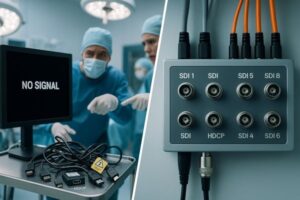Electromagnetic interference can corrupt medical images. This invisible threat compromises diagnostic accuracy and patient safety. Robust EMI shielding technology offers a foundational defense, ensuring visual data remains pristine and reliable.
This article explores the critical role of Electromagnetic Interference (EMI) shielding in medical displays. I will cover the threats EMI poses, effective shielding methods, material considerations, system-wide EMC alignment, miniaturization challenges, regulatory compliance, and Reshin’s advanced multilayer shielding design for ensuring display stability and safety.
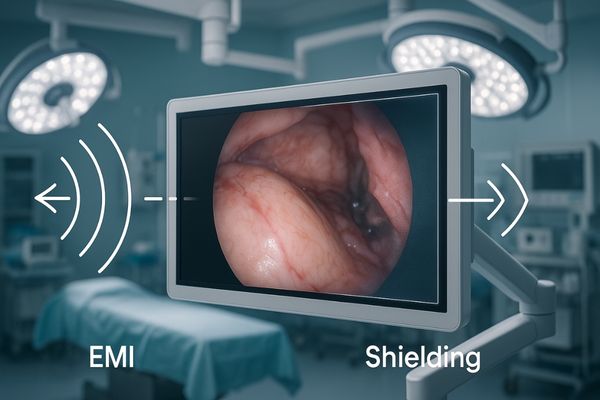
In modern medical environments, a vast array of electronic devices operates in close proximity. This density creates a complex electromagnetic landscape where interference is a constant risk. For medical displays, which translate critical data into visual information, maintaining signal integrity1 is non-negotiable. Shielding2 is the key technology that isolates a display from this electronic noise, preserving its performance and reliability. It is no longer a peripheral feature but a core design requirement integral to the safety and function of advanced medical imaging systems.
EMI shielding3 is a foundational requirement for modern medical imaging systems. In environments like operating rooms or intensive care units, displays operate alongside patient monitors, electrosurgical units, and life support equipment. Each device emits electromagnetic energy that can degrade display performance, causing issues like jitter, artifacts, or complete signal loss. Radiated emissions from a display can also interfere with highly sensitive equipment such as ECG monitors, creating a bidirectional risk profile. The increasing integration of wireless medical devices and AI-driven diagnostic systems further complicates the electromagnetic environment, elevating the importance of EMI control. It is essential for ensuring not only diagnostic accuracy but also the safe interoperability of all connected systems. The MD120C is designed with this complexity in mind, incorporating advanced shielding to maintain its performance and safeguard surrounding devices in high-density clinical settings. Failure to address EMI at the design level can have direct consequences for patient outcomes.
EMI is a major threat to display stability
Unstable displays threaten clinical confidence. Subtle flickers or artifacts caused by EMI can lead to diagnostic misinterpretations. Proper shielding technologies are essential to guarantee the stable, clear images professionals require.
Electromagnetic interference from nearby medical equipment directly threatens display stability and image integrity. It manifests as visual disturbances like screen flickering, color distortion, or static, undermining a clinician’s ability to make accurate assessments and compromising patient safety.
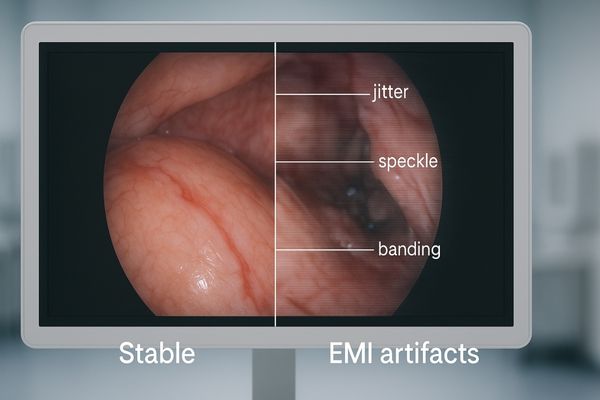
The stability of a medical display is paramount. Clinicians rely on a consistent, artifact-free image to detect subtle anatomical details or abnormalities. When a display is exposed to electromagnetic interference4, its internal electronics can misinterpret signals, leading to degraded visual output. This instability is not merely an inconvenience; it poses a tangible risk. For a radiologist interpreting a mammogram or a surgeon navigating with an endoscopic feed, any image distortion can obscure critical information. The problem is compounded by the fact that EMI is invisible and its source is not always obvious. It could originate from a nearby electrosurgical knife, a mobile X-ray unit, or even a staff member’s smartphone. This makes robust internal shielding5 a non-negotiable feature. Displays like the MD85CA are engineered to operate flawlessly within these electromagnetically dense environments, ensuring that the image on the screen is a faithful representation of the source data, free from external influence. This resilience is a key component of patient safety.
Effective shielding addresses both radiated and conducted EMI
Interference can travel through the air or along power cables. A partial solution only addresses half the problem. Comprehensive shielding must block both pathways to ensure total system integrity.
Effective shielding design uses a dual approach. It incorporates conductive enclosures and gaskets to block airborne radiated EMI, while also using filters on power and signal lines to suppress conducted EMI, ensuring complete protection.

A complete EMI shielding strategy6 must account for two distinct types of interference. Radiated EMI travels through the air as electromagnetic waves and is blocked by creating a Faraday cage effect using conductive enclosures, meshes, and gaskets. This prevents external fields from penetrating the device and internal fields from escaping. Conducted EMI, on the other hand, travels along physical connections like power cords and data cables. It requires a different approach, utilizing components such as filters, ferrites, and transient voltage suppressors installed directly on I/O ports and power supply inputs. A display that only shields against radiated EMI remains vulnerable to noise entering through its power source. For surgical monitors like the MS275P, which connect to multiple instruments within an OR tower, addressing both pathways is essential. Without comprehensive protection, conducted noise from one device could easily travel through shared power lines and disrupt the display’s performance. By integrating both shielding and filtering into the core design, we ensure the monitor remains a stable and reliable instrument regardless of the electrical environment.
Material choice directly affects shielding and heat performance
Selecting a shielding material is not straightforward. The wrong choice can solve the EMI problem but create another. An ideal material must balance electrical conductivity with thermal management needs.
The choice of shielding material involves a critical trade-off. Highly conductive metals like copper and aluminum offer excellent EMI protection but can trap heat, while other materials balance shielding effectiveness with necessary thermal dissipation properties.
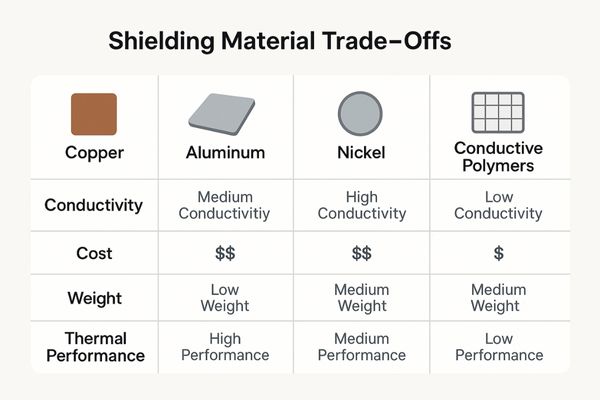
The effectiveness of an EMI shield7 is fundamentally tied to the properties of the materials used. High-conductivity metals like copper and aluminum are excellent at reflecting and absorbing electromagnetic waves, providing superior shielding. However, these materials can also create a thermally insulated box, trapping heat generated by the display’s own electronics, such as the backlight and power board. Overheating can degrade component longevity and affect image uniformity and brightness. Therefore, the design process involves a careful balancing act. The solution often involves using a combination of materials and design features. For instance, a robust aluminum chassis provides structural integrity and primary shielding, while strategically placed vents with conductive mesh covers allow for airflow without compromising the EMI barrier. For a large-format surgical display like the MS550P, which generates significant heat, thermal management8 is just as critical as EMI protection. The design must manage both to ensure long-term reliability in the demanding environment of an operating room. The selection of materials is therefore a strategic decision that impacts performance, safety, and product lifespan.
EMI Shielding Material Properties
| Material | Conductivity | Cost | Weight | Thermal Performance |
|---|---|---|---|---|
| Copper | Very High | High | Heavy | Good |
| Aluminum | High | Medium | Light | Excellent |
| Nickel | Medium | High | Heavy | Good |
| Conductive Polymers | Low-Medium | Low | Very Light | Poor-Fair |
Display shielding must align with system-wide EMC
A shielded display is only one part of the solution. If other devices in the system are not compliant, interference can still occur. System-wide Electromagnetic Compatibility (EMC) is the ultimate goal.
A single well-shielded display cannot guarantee system stability. True Electromagnetic Compatibility (EMC) is achieved only when the display, power supply, and connected devices are all designed to work together without causing or being susceptible to interference.
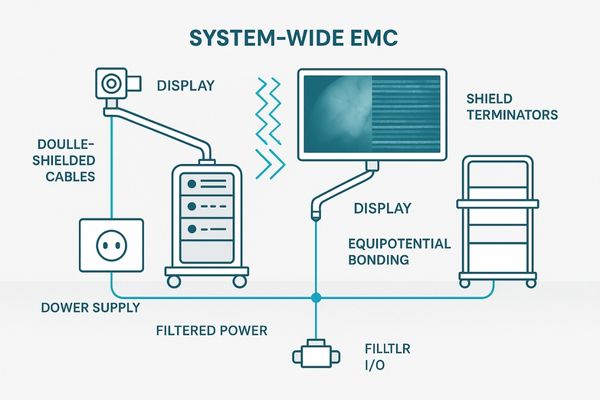
A medical display rarely operates in isolation. It is typically part of a larger imaging system that includes a video source (like an endoscope camera), a processor, a power supply, and various cables. Achieving true Electromagnetic Compatibility9 requires that every component in this chain is designed to control its own emissions and withstand external interference. A perfectly shielded monitor can still show artifacts if its power cable picks up conducted noise from a faulty power supply. Similarly, an unshielded camera cable can act as an antenna, introducing interference directly into the video signal before it even reaches the display. This is why a system-level approach to EMC is essential. In developing products such as the MS321PC, we don’t just test the monitor alone. We assess its performance as part of a complete surgical imaging tower10. This ensures that all components, from the camera head to the display panel, are mutually compatible and that the system as a whole meets stringent medical EMC standards, providing reliable performance in a real-world clinical setting.
Miniaturization demands more refined EMI strategies
Making devices smaller creates new shielding challenges. There is less space for traditional shields, and components are closer together. This proximity increases the risk of internal cross-talk and interference.
As medical displays become thinner and more compact, traditional bulky shielding is no longer viable. Miniaturization requires innovative strategies like board-level shielding, conductive coatings, and integrated gaskets to manage EMI in tightly packed spaces.

The trend toward smaller, lighter, and more portable medical devices presents significant challenges for EMI shielding11. In a compact design, electronic components are placed much closer together, increasing the likelihood of one component’s emissions interfering with another’s operation. Furthermore, there is simply less physical space available for traditional thick metal enclosures or large ferrite beads. This necessitates a shift toward more sophisticated and integrated shielding techniques. Instead of shielding the entire device with one large box, we must use board-level shielding12, where small metal "cans" are placed over specific sensitive circuits or high-emissions components directly on the printed circuit board (PCB). Thin conductive coatings or foils can be applied to internal plastic structures to provide shielding without adding significant bulk or weight. For a compact monitor like the MS192SA, these micro-shielding strategies are critical. They allow the device to maintain a slim profile suitable for space-constrained environments while still achieving the high level of EMI immunity required for medical use, preventing internal cross-talk between the video processing and power supply circuits.
Compliance with IEC 60601-1-2 is essential
Medical devices must meet strict safety and performance standards. IEC 60601-1-2 defines the requirements for electromagnetic compatibility. Compliance is not optional; it is a prerequisite for market access.
Adherence to the IEC 60601-1-2 standard is mandatory for medical displays. This standard ensures a device will not produce harmful interference and can operate safely as intended within its expected electromagnetic environment, guaranteeing clinical reliability.
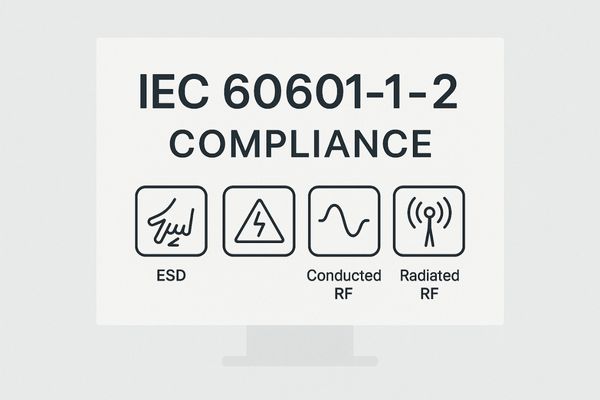
Compliance with IEC 60601-1-2 is a fundamental requirement for any electronic medical device. This international standard establishes the essential performance and safety benchmarks for electromagnetic compatibility13. It is divided into two primary areas: emissions and immunity. A device must not emit electromagnetic energy above specified limits that could interfere with other equipment. Conversely, it must be able to withstand a defined level of incoming electromagnetic interference without degradation of its essential performance. For a diagnostic monitor14, this means the device must continue to display a clear, accurate image even when subjected to radiated fields from sources like two-way radios or conducted disturbances from the power grid. Rigorous testing in certified laboratories is required to prove compliance. Every diagnostic display, including the MD52G, undergoes this comprehensive testing to ensure it meets or exceeds these global standards. This provides healthcare institutions with the assurance that the equipment they procure is not only effective but also safe for use in complex patient care environments where multiple electronic systems must coexist reliably.
Key Immunity Tests in IEC 60601-1-2
| Test Type | Description | Purpose |
|---|---|---|
| ESD (Electrostatic Discharge) | Simulates static shocks from human contact. | Ensures device recovers from static electricity. |
| Radiated RF Immunity | Exposes device to radio frequency fields. | Simulates interference from radios, phones. |
| EFT (Electrical Fast Transient) | Applies rapid bursts of voltage to power lines. | Simulates switching of inductive loads. |
| Surge | Applies high-energy pulses to power lines. | Simulates lightning strikes or power switching. |
| Conducted RF Immunity | Injects RF energy onto cables. | Simulates interference from connected devices. |
| Voltage Dips/Interrupts | Simulates brownouts and blackouts. | Ensures stable operation during power fluctuations. |
Reshin applies multilayer shielding in design
A single shielding method is often insufficient for medical-grade performance. A more robust approach combines multiple techniques. We use a multilayer strategy to create a comprehensive defense against EMI.
Our design philosophy integrates multilayer shielding at every level. This includes a metal chassis, internal board-level shields, and conductive gaskets to create a comprehensive barrier against all forms of electromagnetic interference, ensuring maximum display stability.
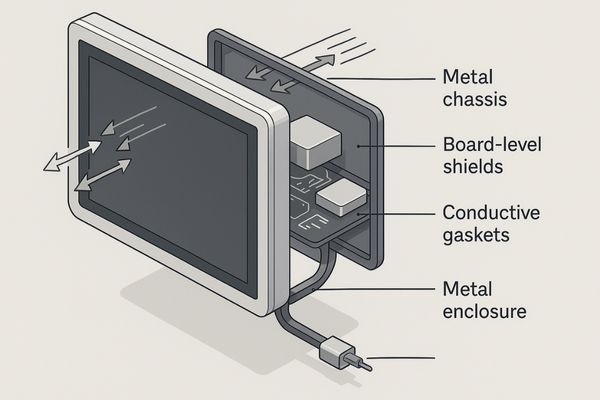
To achieve the highest level of EMI protection, we implement a multilayer shielding methodology15 in our displays. This approach goes beyond a simple metal box and integrates protection at multiple levels of the design. The first layer is the external chassis, typically constructed from aluminum, which provides the primary barrier against external radiated interference. The second layer consists of internal board-level shielding, where critical processors and high-frequency circuits are isolated with their own dedicated metal enclosures to prevent internal cross-talk. The third layer involves securing all seams and openings; any gap in a shield can act as a slot antenna, allowing EMI to leak in or out. We use conductive gaskets and EMI meshes on vents and panel seams to ensure the integrity of the Faraday cage16. Finally, we implement robust filtering on all power and I/O ports to eliminate conducted interference. This layered defense is built into every surgical monitor, including the MS321PB, ensuring it can perform reliably in the most demanding electromagnetic environments of the modern operating room.
Conclusion
EMI shielding is a foundational requirement in medical display design, directly ensuring patient safety, diagnostic accuracy, and system interoperability in today’s complex healthcare environments.
📩 Need medical displays with robust EMI shielding for demanding clinical settings? Contact Martin at martin@reshinmonitors.com to explore Reshin’s certified solutions.
-
Exploring this topic will provide insights into the critical role of signal integrity in ensuring accurate medical data representation. ↩
-
Understanding shielding can enhance your knowledge of how medical displays maintain signal integrity and reliability. ↩
-
Understanding EMI shielding is crucial for ensuring the performance and safety of medical devices in clinical settings. ↩
-
Understanding electromagnetic interference is crucial for ensuring the reliability of medical displays, which directly impacts patient safety. ↩
-
Exploring the importance of robust internal shielding can help you appreciate how it protects against image distortion in critical medical environments. ↩
-
Understanding EMI shielding strategies is crucial for protecting devices from interference, ensuring optimal performance. ↩
-
Understanding EMI shields is crucial for anyone involved in electronics design, ensuring effective protection against electromagnetic interference. ↩
-
Exploring thermal management techniques can enhance the reliability and performance of electronic devices, especially in demanding environments. ↩
-
Understanding Electromagnetic Compatibility is crucial for ensuring the reliability of medical imaging systems, making this resource invaluable. ↩
-
Exploring the components of a surgical imaging tower can enhance your knowledge of medical technology and its applications in clinical settings. ↩
-
Explore this link to understand effective EMI shielding techniques crucial for modern medical devices. ↩
-
Learn about board-level shielding to see how it enhances performance in compact electronics. ↩
-
Understanding electromagnetic compatibility is crucial for ensuring the safety and effectiveness of medical devices in complex environments. ↩
-
Exploring the features of diagnostic monitors can help you appreciate their role in patient care and the importance of compliance with standards. ↩
-
Explore this link to understand how multilayer shielding enhances EMI protection, ensuring reliable performance in sensitive environments. ↩
-
Learn about the Faraday cage’s role in EMI protection, crucial for maintaining device integrity in electromagnetic environments. ↩



